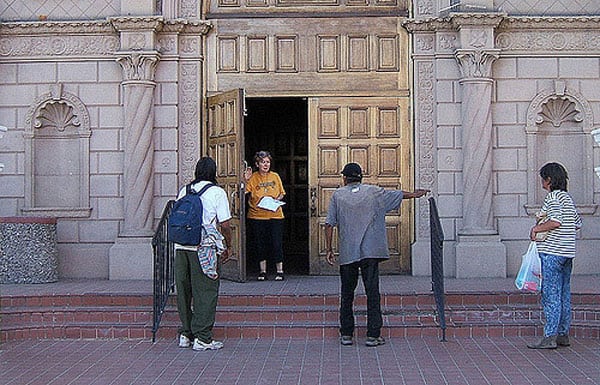
July 16, 2018; Washington Post
In Alexandria, Virginia, located across the Potomac from Washington, DC, “the area’s affordable-housing crisis deepened as low-income people poured into the region while low-income units disappeared,” Hannah Natanson of the Washington Post explains. Between 2000 and 2017, Natanson adds, “upscale redevelopment projects and rising rents in the city slashed by 90 percent the quantity of apartments affordable to those who earn roughly 50 percent of the area’s median income.”
This dramatic change has forced local officials and nonprofits to think differently about affordable housing. Last week, NPQ profiled a nonprofit that collaborated with the building’s owner to convert an abandoned shopping mall into homes for the homeless. In a similar way, churches have become part of Alexandria’s affordable housing strategy.
Helen McIlvaine is Alexandria’s director of housing. She sees many possibilities. “I go past a Scottish Rite [Masonic] temple and say, ‘Do they really need all that land?’ Once you start looking, you can’t stop—there are opportunities everywhere,” McIlvaine explains.
According to Natanson, McIlvaine over the past five years has succeeded in “shepherded four churches through selling or leasing all or part of their land and converting it to space for affordable housing.” McIlvaine adds that two more churches are “in the pipeline.”
The way this works, Natanson explains, is pretty straightforward:
Most houses of worship follow the same script, selling their land outright to a nonprofit developer or signing on to a ground lease, which allows the developer to build and operate the affordable-housing units while the church retains ownership of the land. The units built are usually designated for people who make 40 to 60 percent of the area’s median income.
Sign up for our free newsletters
Subscribe to NPQ's newsletters to have our top stories delivered directly to your inbox.
By signing up, you agree to our privacy policy and terms of use, and to receive messages from NPQ and our partners.
The construction fee is driven down by low-income-housing tax credits, which the government grants to affordable-housing investments. Still, each unit can cost hundreds of thousands of dollars to build. This means churches and their nonprofit developer partners often face a “gap” in the financing, as McIlvaine calls it—and that’s where the city steps in.
In each of the church projects McIlvaine has undertaken, the city of Alexandria contributed a long-term loan often amounting to several million dollars. McIlvaine said the Office of Housing typically receives a yearly budget of between $4 million and $6 million that it can dedicate to affordable-housing initiatives.
Of course, Alexandria is hardly the only place in the region to lack adequate affordable housing. In response, says Natanson, “Churches across the District, Maryland, and Virginia are turning their properties into living space for low-income residents.”
For instance, David Bowers, vice president of the national nonprofit Enterprise Community Partners, says Enterprise has helped seven houses of worship in the Baltimore-Washington region engage in similar arrangements to those in Arlington, VA. According to Bowers, the Mid-Atlantic region has become a national leader in church-based housing partnerships. Enterprise formed its Faith-Based Development Initiative to encourage this strategy in 2006. Bowers adds that Enterprise is pursuing opportunities with roughly two dozen more churches and is beginning to promote the model beyond the mid-Atlantic region.
As Natanson explains, neither Arlington nor rest of the DC metropolitan area were immediate enthusiasts. But McIlvaine, before beginning work for the city in 2006, had worked at a local nonprofit, the Arlington Partnership for Affordable Housing (APAH), where McIlvane “had launched First Baptist Church of Clarendon on its long and contentious—but ultimately successful—fight to build affordable units on its land.” Natanson adds that, “The church was one of the first in the area to try its hand at affordable housing, and McIlvaine wanted to keep a good thing going.” Seven years later, in 2013, Alexandria’s Housing Master Plan “for the first time in city history…specifically suggested places of worship as a source of affordable housing.”
McIlvaine notes that the “sale and construction process is long and taxing.” Housing project often take between five and seven years to complete. To ease the path, Natanson notes that Nina Janopaul, president of APAH, “has developed a seven-step program” to guide churches through the process. These steps, Natanson explains, include discernment (setting the vision and identifying resources), team building, a feasibility study, construction and, finally, celebration.
For the churches, many of whom have lost parishioners and have surplus land, the arrangements often help them financially. Of course, the work is often well aligned with their missions. “In Matthew 25, we are called to feed the hungry, clothe the naked,” notes Rev. Sam Marullo, a former professor at the District’s Wesley Theological Seminary. “I would add into that Matthew 25 quote, ‘Build housing for those that need housing.’”—Steve Dubb











